The Sketchbook Voyage
Now my tour of duty on P&O ‘Aurora’ is at an end, I’m trying to summarise some of the watercolour and drawing techniques that I touched on during 22 sea days, most of which will be in my book on watercolours when I manage to finish it, which will be soon! I spent most of my spare time on the ship working on the edits and illustrations… honest. Well, some of the time. Well ok, a couple of hours a day. I’ve been busy!
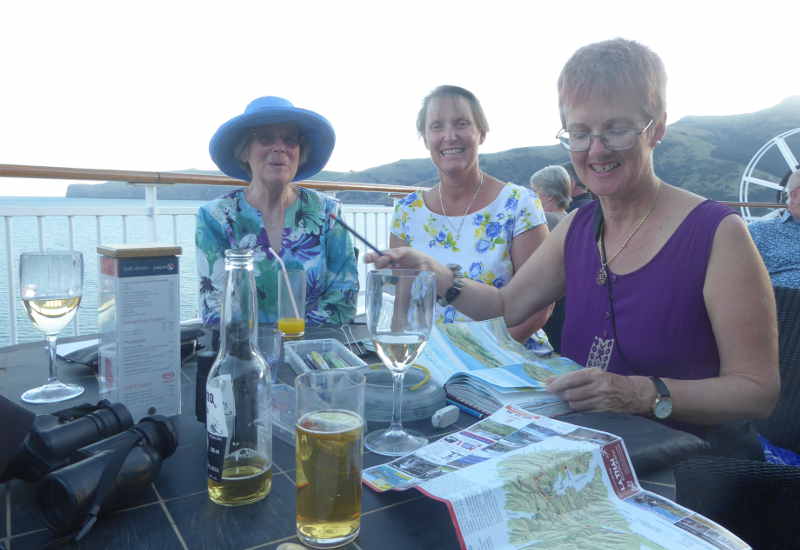
I’ve enjoyed keeping a ‘Carnet de Voyage’, as I usually do, and have been urging my students to do the same, in their own way, to sketch for fun and create a lasting record of their own impressions and experiences. Everyone loves the idea but it can be hard to know how to start, so by way of encouragement here are my answers to the main questions I’ve been asked ….
Are you going to make finished paintings of your sketches?
No, that’s not why I sketch. Yes, I do produce finished paintings from time to time, using a combination of sketchbook notes, memory, imagination, on the spot drawing or photographs, but it would be very inhibiting if I only drew subjects that I felt would make a finished painting. For me, it’s the process of drawing that counts, and it has an indirect effect on the quality of my painting and illustration. A musician practices every day, and a runner runs every day. It’s what you do to keep your senses and skills alive.
>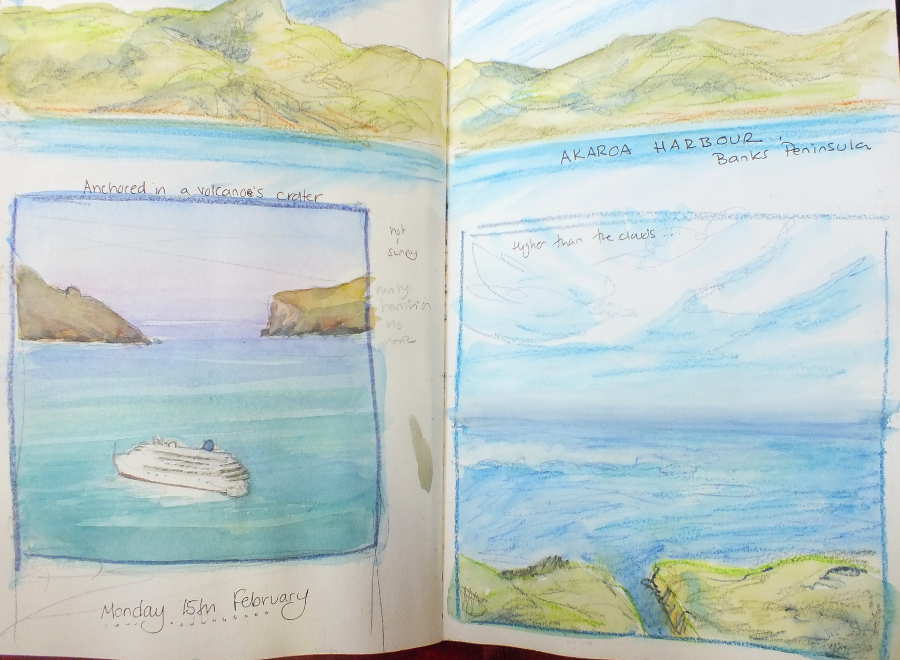
But if I’m an amateur artist, why bother sketching at all? Isn’t it easier just to take a photograph?
Sketching deepens your appreciation, sharpens your observation, helps you engage fully with the present moment. It stops you making assumptions about what you are seeing, slows you down and helps you spend time with your surroundings.
When you try and draw something, you have to look at it as if you have never seen it before, because you are aiming to record what you actually see, not what you assume you are seeing – there is a big difference. Even the act of trying to draw connects you to an experience in a way that is memorable and intense. Snapping away with a camera can sometimes have the opposite effect, as if you are saying to your brain: ‘You don’t need to look carefully or remember this now, we’ve got a photo so we can look at it later’. Nothing wrong with taking photographs of course – we all do it and it’s of great value, especially for capturing experiences and recording close up detail – but it can take over and become a habit. Do yourself a favour and put the camera or ipad down next time you see a beautiful sunset. Look at it direct without an electronic screen in the way. Spend time, use your eyes, develop your visual memory of the colours you see.
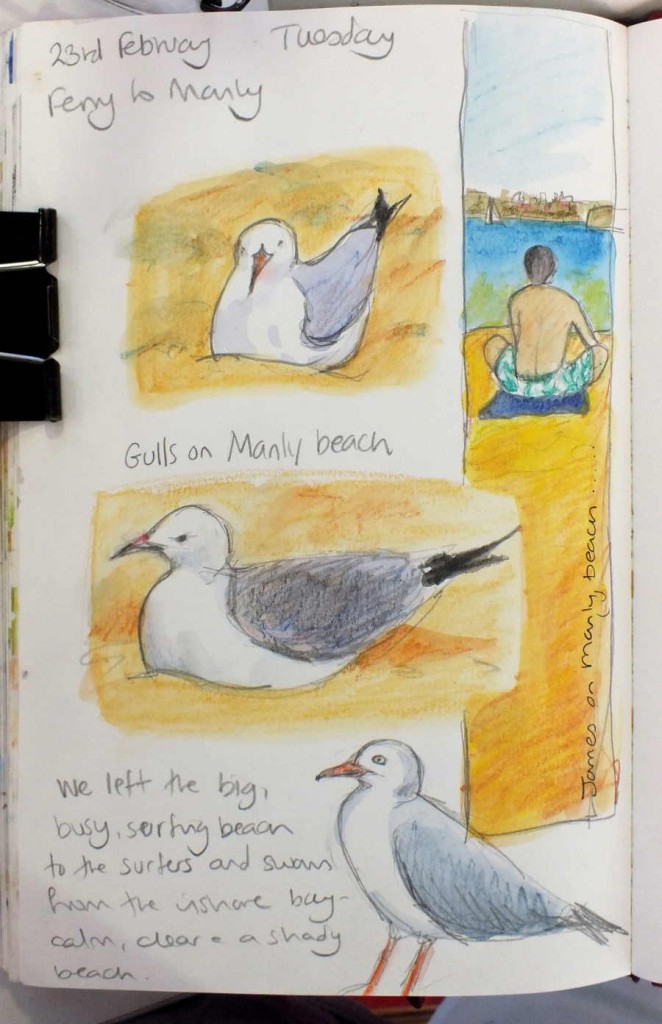
Everything is worth drawing, not just pretty scenes. Draw for practice, draw for fun, draw to help you understand and appreciate. Draw to develop your artist’s eye that sees the world as a series of fascinating shapes, patches of colour, light and dark. Whatever level you aspire to, it repays the effort.
Why is sketching in public so embarrassing? How do you get round this?
A sketchbook is by its nature imperfect and personal, and that’s why it can be quite daunting to sketch in public. What happens if someone looks over your shoulder when you’re drawing and what’s on the page is a load of rubbish? What will they think? Here are a few ways round it:
– Mix words and pictures on the page – if people see you writing rather than drawing they will usually back off (why are diaries considered private but sketchbooks not, I wonder?).
– Use a small sketchbook and pencil so that you can draw discreetly in public places You can always add colour later.
– Sit with your back to the wall, or against a rock.
– Draw when there’s no-one else around – early morning is good – or in quiet places. Build up your confidence by drawing at home or in friends’ houses and gardens.
– Decide to do it anyway – life’s too short to worry what people think. They are usually envious because you are doing it and they aren’t!
– Most of all, take the pressure off – it’s only a sketch. You don’t have to show your book to anyone if you don’t want to. It’s your diary, an accurate reflection of your life that day. It doesn’t have to come up to anyone else’s artistic standards any more than your written diary has to be literary enough to compete with a Booker Prize winner. But if you do show someone, it will probably communicate more about your experience than a photograph would.
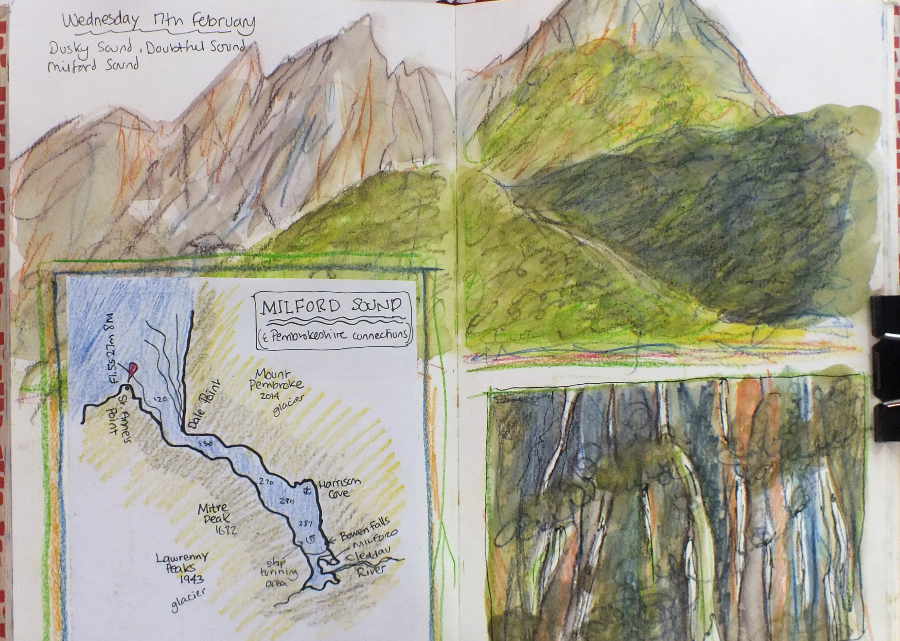
How do I start?
Buy a hardback sketchbook that you really like the feel of, in a size that’s comfortable to use and easily transportable. Thick cartridge paper works best; as it fills up it stops feeling pristine and empty and starts to go crinkly and interesting. If there isn’t an elastic strap around it to keep it shut, then you might need to use a bulldog clip to hold it closed.
When I started sketching, I would turn to a new page in the sketchbook feeling a bit daunted. My marks were a bit pale and wobbly, lacking in confidence as if they were not sure where they were going. As more lines went wrong, frustration set in and I’d give up, turning the page, ready to make the same mistake again. I wanted my sketchbook to be an exciting visual diary of my life, not a series of half-drawn disappointments.
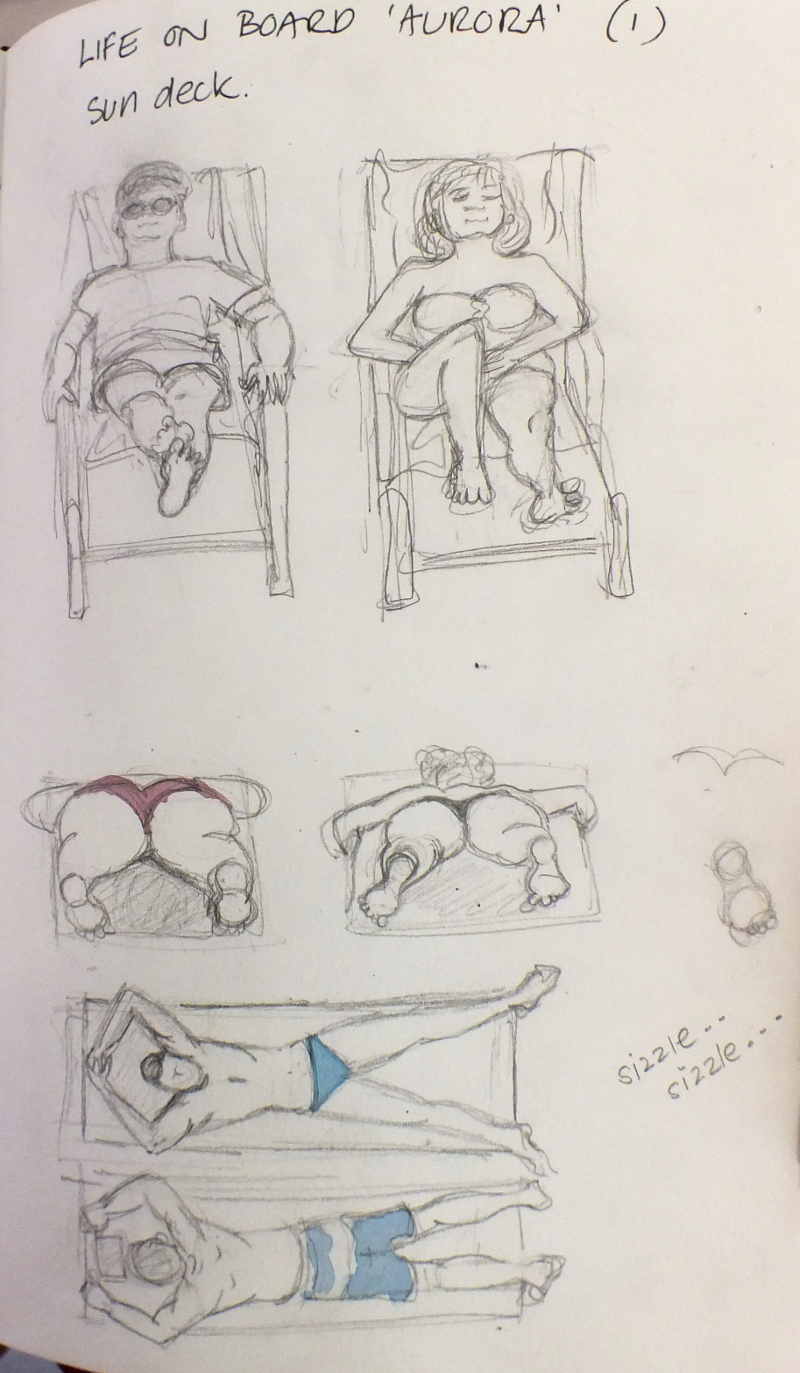
Here are a few tips to make your sketchbook bolder from the start, and encourage you along the way:
– Put some colours or a border around the edges to liven up the white space before you start.
– Don’t just do one drawing on a page then turn over – fill the page with fragments, bits and pieces, doodles, patches of colour, unfinished drawings, and let them all overlap and mix together. The result will be far more meaningful than a hesitant pencil drawing in the middle of the page. If it goes wrong, draw something else on top of it!
– Use words and pictures together to make notes and recollections of the scene. I feel that words and pictures belong together and it’s a shame they ever became separated.
– Don’t feel you have to draw everything that’s in front of you. Start with the bit that interests you most and stop when you’ve had enough.
– Use collage. Stick onto your pages ferry tickets, fragments of brochures, maps, dried leaves or drawings you’ve done on other bits of paper. This has the dual purpose of adding texture and interest, and also covering up any particularly wobbly drawings.
As you gain confidence, your sketchbook will become bolder, more colourful, more fun – a reflection of you and your life in all its joys and wobbles.
What if I’m just not very good at drawing?
The more you sketch, the better you’ll be, and there are plenty of techniques to help you learn. The main way to improve is to pay attention to what you are actually seeing, not what you assume you are seeing. Take notice, spend time. Question what you are seeing. Here’s an example:
‘Boats are difficult!’ said one of my students. ‘I can see it’s not right but I don’t know why.’
‘What shape is the bow?’ I asked, pointing to the boat in question.
He looked again. ‘Ah! It’s straight’, he said
‘So why have you drawn it curvy?’
‘I didn’t notice that.’
‘See, it’s not that you can’t draw, you just didn’t ask yourself the question: ‘what shape is the bow?’ You drew any old bow, any old shape, instead of the one that was in front of you. That’s not inability to draw, that’s just not taking the trouble. So that’s something you can put right!’
In the meantime, make all those mistakes, because you have to get the wobbly drawings out before you can get to the better ones that lie buried deep underneath those hours of experience and trying. What matters is that you draw with passion and enthusiasm, draw like you mean it, and that will keep you at it. All sketches are good ones, because time spent drawing, pausing to connect with the detail of your world, is incredibly life enhancing regardless of whether the result is a mess of lines or a coherent drawing. It’s the act of doing that changes the way you think and the way you see.
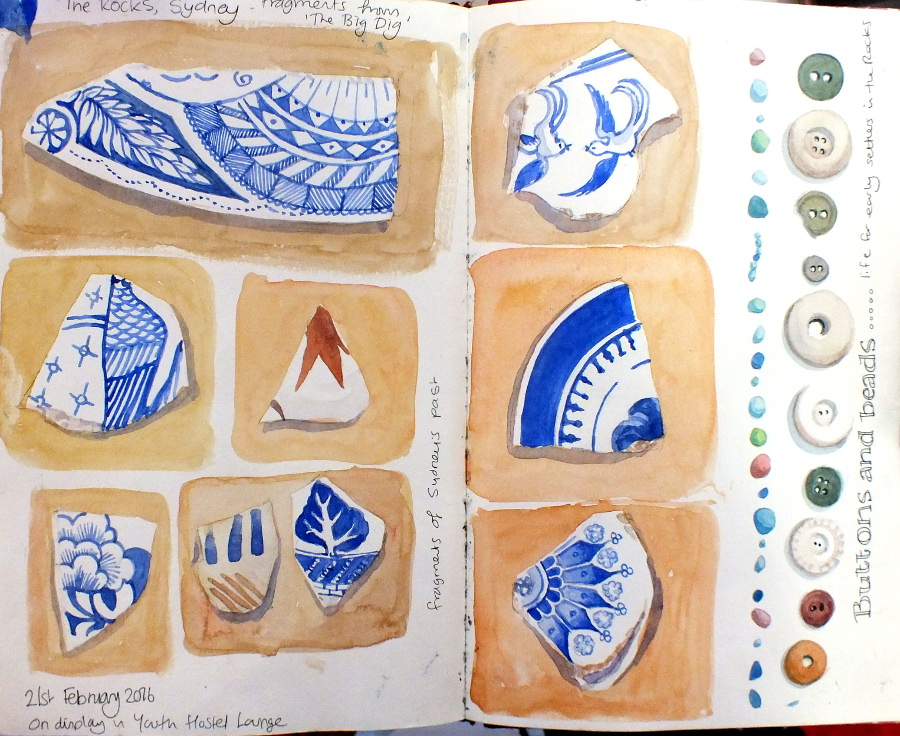
So if you’re struggling and your art has got stuck, I urge you to forget about trying to produce finished paintings for a while. Forget about perfection, stop trying to fill a rectangular piece of paper with something worth framing. Buy a hardback sketchbook in a size that feels good to handle and fill every page with lines, colours, doodles, fragments, frustrations and mistakes. Silence the inner critic whilst you go out to play. You will be walking the same road as every artist, known and unknown, who produced paintings worth looking at.

Brilliant! The sketch of sunbathers on loungers attracted my attention (as I’m useless at drawing people) but your guidance on drawing to enjoy it and improve, rather than trying to produce a finished picture worthy of framing certainly hit home!
I’m now inspired to just relax and enjoy it..does it really matter if it’s not ‘worth’ framing or no one else likes it! Phew! Relief! Thank you
I love your blue and white fragments of china and the buttons. Thanks for your advice on sketching. I never do much of it and should.
i really enjoyed your lessons and continue to be inspired by your comments pleased to see you did get to see the fiords. it can be so wet in that area. Cheers Cushla